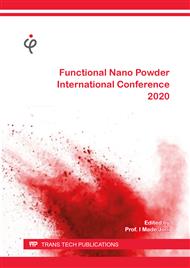p.91
p.103
p.113
p.121
p.133
p.143
p.153
p.165
p.171
Soil Acidity, Organic Carbon and Basic Cations as Affected by Nanoparticle of Volcanic Ash and Biofertilizer in Inceptisols
Abstract:
Nanoparticle has been used in agricultural practices such as soil ameliorant. Nanoparticle of volcanic ash and biofertilizer were applied to improve some soil characteristics of Inceptisols. The objective of this research was to optimize the benefit of nanoparticle of volcanic ash and biofertilizer in reducing soil acidity, increasing organic carbon content, and increasing basic cations of Inceptisols. Volcanic ash was obtained from the eruption of Mt. Merapi in Central Java. Nanoparticle was grinded in Nanotechnology and Graphene Research Center, Universitas Padjadjaran. Phosphate solubilizing fungi was used as biofertilizer, isolated in Soil Microbiology Laboratory, Universitas Padjadjaran. A two factors randomized experimental design was used in this research. Nanoparticle of volcanic ash was used as first factor (four levels: 0%, 2%, 4% and 6% of soil weight percentages). Biofertilizer was used as second factor (two levels: 0 and 10 g.kg-1). These two treatments were combined and mixed evenly and incubated for three months in field condition. Every month during those three months a few soil samples were taken to analyze the change of soil characteristics. The results showed that the treatments increased organic carbon content and potassium basic cation but had no effect to soil acidity.
Info:
Periodical:
Pages:
133-142
Citation:
Online since:
August 2021
Price:
Сopyright:
© 2021 Trans Tech Publications Ltd. All Rights Reserved
Share:
Citation:


